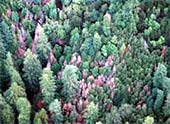Sudden Oak Death — Phytophthora ramorum
The plant pathogen, Phytophthora ramorum, which causes the disease known as Sudden Oak Death (SOD), was recently discovered on horticultural nursery stock in Oregon, Washington, and British Columbia. The name of the disease is somewhat misleading, as the pathogen attacks many plants other than oaks. The current host list contains plants from many plant families (i.e. Douglas-fir, rhododendron, vaccinium, madrone, pieris, virburnum, and camellia) that are extremely important to the ornamental, small fruit, Christmas tree, and forest industries in Washington State. If this pathogen becomes established in Washington, resulting quarantines relating to the movement of hosts of this pathogen from quarantined areas have the potential to impact individuals and companies who sell their products locally as well as those who export them out of state or to other countries.
In order to help bring professionals up-to-speed on this disease, a cadre of university, state and federal agency personnel developed a one-day informational conference on SOD. The conference was held on July 9th, at the WSU-Puyallup Research and Extension Center. The invited speakers provided information on several key issues: SOD Overview; current SOD surveys in Washington State; PNW SOD Research; SOD Regulatory Issues; and Industry Perspectives.
Since space was limited and only 132 people were able to attend this conference, each of the presentations was video taped and is available for viewing. In addition to increasing the dissemination of the information presented at this conference, it is our hope that these video presentations will stimulate a continuing dialogue between all interested parties.
Sudden Oak Death Informational Meeting
Video presentations of the Sudden Oak Death Informational Meeting held at the Washington State University Puyallup Research and Extension Center July 9, 2003 are available for viewing as videostreams.
The videostreams will only work using Internet Explorer with Windows Media Player and will NOT work using either a Macintosh system or the Netscape browser.
Viewing Requirements
The following software is required to playback a Microsoft Producer presentation:
- Microsoft Windows 98 operating system (or higher), or the Microsoft Windows NT 4.0 operating system (or higher)
- Microsoft Windows Media Player 6.4 (or higher)—Windows Media Player 7.0 or higher is recommended to optimize presentation playback
- Microsoft Internet Explorer 5.0 (or higher)
Icon Descriptions
| Recommended for dial-up modems (good for any modem greater than 33 kbps). Click on the small video icon to view the presentation with the smaller video file. The presentation is cued up with the speaker’s commentary, and will change slides automatically. | |
| Recommended for high-speed connections. Click on the large video icon to view the presentation with the larger video file. The presentation is cued up with the speaker and will change slides automatically. |
Acknowledgments
Presentation Directory
|
OVERVIEW OF CURRENT SOD SITUATIONS
|
Videostreams
|
||
|
Low
|
High
|
Time
|
|
| California – Susan Frankel, USDA Forest Service, CA |
31:44
|
||
| Oregon – Gary McAninch , Oregon Department of Agriculture |
23:51
|
||
| British Columbia – Jon Bell, Bio-Surveys, BC |
21:36
|
||
| Washington – Tom Wessels, Washington State Department of Agriculture |
12:07
|
||
|
CURRENT WASHINGTON STATE SOD SURVEYS
|
Videostreams
|
||
|
Low
|
High
|
Time
|
|
| APHIS/WSDA Ornamental Nurseries – Art Wagner, Washington State Department of Agriculture |
27:09
|
||
| USFS/DNR Forests – Dan Omdal, Washington State Department of Natural Resources |
7:42
|
||
| PNW Research Overview – Gary Chastagner, Washington State University |
10:07
|
||
| PNW Research Overview – Bob Linderman, Oregon State University |
21:49
|
||
|
REGULATORY ISSUES
|
Videostreams
|
||
|
Low
|
High
|
Time
|
|
| USDA-APHIS – Jonathon Jones, National Phytophthora Ramorum Program Manager |
15:55
|
||
| WSDA – Brad White, Washington State Department of Agriculture |
5:31
|
||
| CFIA – Rob Ormrod, Horticulture Specialist, West Canadian Food Inspection Agency |
13:42
|
||
|
INDUSTRY PANEL DISCUSSION
|
Videostreams
|
||
|
Low
|
High
|
Time
|
|
| Ornamentals – Dan Meier, Briggs Nursery, Olympia |
5:17
|
||
| Christmas Trees – Bryan Oslund PNW Christmas Tree Association |
6:34
|
||
| Small Fruit – Tom Walters, Sakuma Brothers, Burlington |
9:06
|
||
| Native Plants – Karen Ripley, Washington State Department of Natural Resources, Olympia, WA |
5:41
|
||
| Forestry (Specialty Products) – Jim Freed, Washington State University, Olympia, WA |
6:57
|
||
| Forestry (Nursery Stock) – Bob Buzzo, Lawyers Nursery, Olympia, WA |
3:04
|
||
| Forestry (Logging and Log Movement) – Robert Edmonds, University of Washington |
5:15
|
||
This conference was developed by the following adhoc committee:
- Pete Bristow, Washington State University Puyallup Research and Extension Center
- Clinton Campbell, USDA – APHIS
- Gary Chastagner, Washington State University Puyallup Research and Extension Center
- Jenny Glass, Washington State University Puyallup Research and Extension Center
- Donald Hanley, Washington State University Natural Resource Sciences, Seattle
- Dan Omdal, Washington State Department of Natural Resources, Olympia
- Karen Ripley, Washington State Department of Natural Resources, Olympia
- Mary Toolney, Washington State Department of Agriculture, Olympia
- Video presentation produced and developed by the Rural Technology
Initiative, a joint UW/WSU program to bring natural resource technology to
rural citizens in the state
Contact: Gary Chastagner, 253-445-4528 | WSU Puyallup Research & Extension Center, 2606 West Pioneer, Puyallup, WA, 98371-4998 USA
Last updated January 2, 2013

 .
.